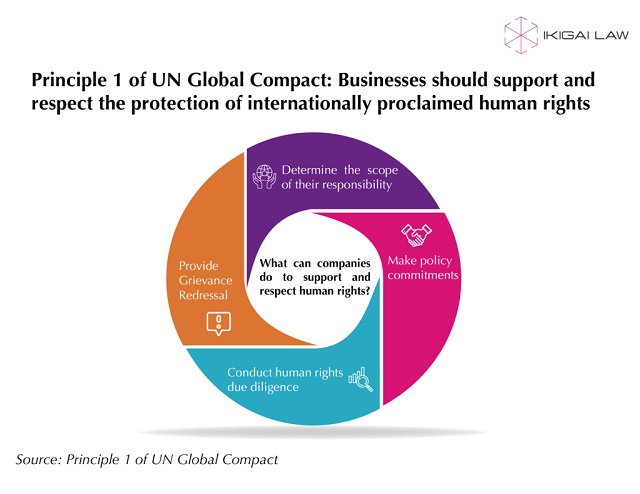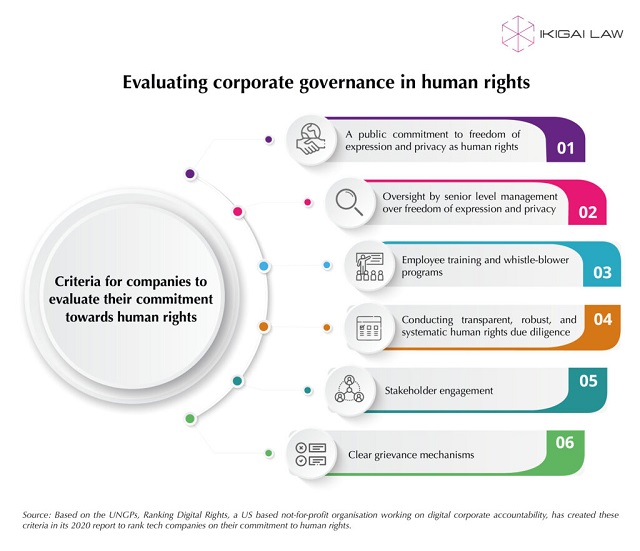The relevance of human rights on business activities of technology companies cannot be understated. Technology's pervasiveness in our lives posits critical questions of privacy, data protection, freedom of speech etc. If violated, human rights can become a significant business risk that entails potential legal, financial and reputational harms. With rising State intervention and public scrutiny, tech companies cannot escape the need to engage with human rights. In this regard, good governance models are key to successfully navigating the terrain of human rights at the intersection of business.
The United Nations Global Compact (Global Compact) also prescribes steps for businesses to proactively engage with human rights.1 Apart from policy commitments, companies should conduct human rights due diligences (HRDDs) and human rights impact assessments (HRIA) to track and mitigate their human rights impact.
In a survey on initiatives to protect human rights undertaken by companies with different backgrounds, KPMG discovered that companies were at different stages of maturity in integrating identification and protection of human rights into their business models.2 KPMG's report identifies the following as building blocks of human rights oriented corporate governance mechanism:
- A company-wide policy or statement on human rights
- Accountability and responsibility with the board of directors and senior management
- Practicing due diligence to identify, prevent and mitigate adverse human rights impact
- Stakeholder dialogue
- Grievance mechanism for remedying adverse impacts on stakeholder

Unequivocal commitment to human rights
The Global Compact calls upon companies to take a clear stand on respecting human rights, and abide by international principles of human rights, such as the Universal Declaration of Human Rights (UDHR).3 In this regard, it is a good idea to have a definitive and defined policy that enunciates a company's responsibility towards protecting human rights. Human rights policy statements also highlight a company's positive contributions to securing human rights.
The responsibility to protect human rights starts at a product's development stage and continues throughout its lifecycle. Balancing a tech product's functionality with its various potential human rights implications is not an easy task. For instance, how will a social media platform balance disinformation and freedom of speech? How will a company guarantee remedies for human rights violations that may result from decisions made by machines and algorithms, rather than humans? A robust company policy on human rights will help resolve these conflicts and mitigate the company's human rights impact.
A company's policy on human rights informs its stakeholders- such as consumers, shareholders and investors- of the company's identity and its human rights benchmarks. In recent times, Facebook's press statements repeatedly stressed on their commitment to free speech. Here, a policy commitment to free speech reassures stakeholders, particularly users, and contextualizes the platforms actions.
Practicing human rights as a robust corporate practice
The responsibility of formulating an efficient internal company policy supporting human rights falls to senior management and the board of directors. In a top-down approach, the board/management sets the tone for other internal operational processes for the rest of the company to imbibe and respect human rights. Directors and senior managers must foster sensitivity and respect for human rights. Their awareness of complex socio-economic issues such as data privacy, application of artificial intelligence, diversity and so on is critical to policy making.4 They must be informed of the business and reputational risks that human rights pose for the company.5 Additional training on human rights is recommended.6
Broad aspirational principles in a human rights policy should be followed by specific methodologies to give meaning to those aspirations.7 Thus, an aspirational commitment to right to privacy must include how and when the product development team must engage with questions of right to privacy in the product's lifecycle.
Articulating human rights expectations will also help a company navigate its business arrangements with government and other State agencies. This is particularly important given data sharing requirements and arrangements between State and private companies. Moreover, the changing regulatory and legal landscape can raise compliance issues as far as human rights are concerned. Integrating human rights into the business model will help the company manoeuvre such changing landscapes.
How can companies implement a policy on human rights?
Like every policy making exercise, the challenge here lies in the implementation. For larger companies, monitoring and implementation across many business units can be difficult. There are a few ways one can go about this. For instance, the International Corporate Governance Network, an investor group that promotes corporate governance standards, recommends creating a board committee to oversee implementation and monitoring.8 On the other hand, KPMG feels that sustainability departments should take the lead on implementation, while company executives oversee the process.9 Some companies hold the heads of their business units responsible for implementation of human rights mechanisms10
As KPMG highlights in its report, stakeholder engagement is a must to ensure transparency of process11 Transparency paves the way to receive critical feedback that can help strengthen policy and processes. A company's investors and shareholders must be informed of its practices and policies as part of accountability measures.12 The board should also encourage internal feedback from employees and establish whistle-blower mechanisms. Nonetheless, the process of establishing a strong and functional human rights framework will likely be an evolving process. A proper response to the error through constant dialogue with stakeholders will shape a powerful company policy.

The scope of a company's responsibilities
Human rights issues that can potentially arise for a company range from labour rights to privacy to free speech, and addressing all of them at once is an impossible task. UN Global Compact identifies three verticals that determine a company's human rights responsibilit13:
- Local human rights context: The socio-political and legal background of human rights differs from country to country. A company must evaluate the human rights context of the country in which it is operating to understand the challenges and liabilities involved.
- Company's human rights impact: A company must assess the human rights impact of its digital product, rights of employees etc. Efforts should be made to remedy these impacts by adjusting policies and changing practices.
- Relationship with external parties: A company must consistently evaluate its relationship with business partners, governments and other State or non-State actors to avoid complicity in any human rights abuse.
Active support for human rights
Companies need to ensure they actively and visibly support human rights. A company must be aware of its impact on marginalised and vulnerable groups and adopt remedial measures as needed.
Companies should ensure human rights sensitivity during product and service design. For tech companies, this could range from data protection to the likelihood of algorithmic biases that could impact communities. For instance, in 2019, a software used by hospitals in United States to allot healthcare to patients was accused of racial bias. It was found that the algorithm was less likely to refer black people to health care programs as it did for white people of similar health status14 Such instances may impact a company's reputation within communities and hinder possibilities of market expansion.
Many companies talk about their positive contribution to human rights in their HRIA reports, notes the UN Global Compact15 Facebook's HRIA report on Sri Lanka notes Facebook's role in promoting free expression and civic engagement in the country for women, LGBTQIA+ individuals and other historically marginalised groups by providing them a cost-effective platform16
What can investors do?
Financial and legal risks posed by human rights violations have the potential of affecting a company's stock value by impacting its reputation. A report by the Office of High Commissioner for Human Rights (UNHR) notes, "socially responsible companies are perceived as less risky by investors and lenders, and companies who address their social and environmental impacts enjoy lower risk premia, placing them in a better position for raising new capital."17
The UNGPs expect investors to play an active role in ensuring responsible business conduct at every stage of a company's lifecycle18 Investors are increasingly leveraging their positions to encourage companies to follow UNGPs. In 2020, investors representing over $4.5 trillion assets called upon companies who scored zero in Corporate Human Rights Benchmarks 2019, an annual assessment conducted by the Institute for Human Rights and Business, to improve their performance on human rights19
Investors can seek accountability from a company's board of directors on its human rights impact.20 Moreover, investors who are interested in sustainable value creation can expect the board to assess the company's social impact21They may ask the company's board and senior management to showcase diligence in understanding human rights risks.22
The International Corporate Governance Network recommends methods for investors to exercise oversight on their holdings with respect to human rights23:
- Proportionate due diligence: Investors can prioritize due diligence based on the size of their holdings operating in in high-risk sectors. External help can be sought to assess all their holdings.
- Portfolio management: Investors can screen companies that are linked to egregious human rights risks. This is a quick and useful strategy for monitoring investment.
- Demand engagement and reports: Investors can support shareholder proposals and ask companies to perform human rights due diligences or issue reports.
- Make and share policy on human rights risk: Investors can make their own policies to assess companies for likely human rights risks. Sharing this policy with companies and other stakeholders can facilitate meaningful conversations on human rights and businesses.
- Public policy engagement and collaboration: Investors can leverage their position and collaborate with other likeminded investors to create impact.
Bringing human rights policies to life
Corporate practices tuned to respecting human rights are incomplete without engaging in HRDDs. Similarly, HRDDs cannot succeed without knowledge of the company's human rights impact. Thus, HRIA processes are crucial to HRDDs. They help companies understand their potential and actual human rights impacts. A responsive HRDD will then take measures to mitigate the impact.
Ranking Digital Rights, an organisation that annually evaluates tech companies' human rights impacts, in its 2020 report,24 highlights a crisis in transparency and accountability amongst tech companies. It notes that many tech companies are unwilling to publicly disclose "how they shape and moderate digital content, enforce their rules, collect and use our data, and build and deploy the underlying algorithms that shape our world."25 The report attributes weak corporate governance, including lack of policy and oversight, as the reason for this crisis.
A healthy due diligence exercise is a must for tech giants who engage with questions of freedom of expression, privacy, and other human rights, on a day-to-day basis. This will help companies identify the risks and take action to prevent or mitigate them. A tech company has a commitment to uphold human rights not only for itself but also to its digital product or service's users. An unequivocal commitment to protecting human rights will not only help a company maintain a good reputation but also a positive investor sentiment.
In our next piece, we will explore practicing HRDD and HRIA exercises.
Footnotes
1 UN Global Compact, "Principle 1: Supporting Human Rights" https://www.unglobalcompact.org/what-is-gc/mission/principles/principle-1
2 KPMG, "Assessing Human Rights in Business" https://assets.kpmg/content/dam/kpmg/xx/pdf/2016/11/addressing-human-rights-in-business.pdf
3 UN Global Compact, "Principle 1: Supporting Human Rights" https://www.unglobalcompact.org/what-is-gc/mission/principles/principle-1
4 ICGN, Governance and Big Tech: Setting the tone on data, privacy and (mis)information (ICGN Viewpoint, March 2021) https://www.icgn.org/sites/default/files/ICGN%20Viewpoint_Governance%20of%20Big%20Tech%20_0.pdf
5 ICGN, 'Human Rights through a Corporate Governance Lens' (ICGN Viewpoint, April 2015) https://www.icgn.org/sites/default/files/Human%20rights%20through%20a%20corporate%20governance%20lens.pdf ; KPMG, "Assessing Human Rights in Business", page 13 https://assets.kpmg/content/dam/kpmg/xx/pdf/2016/11/addressing-human-rights-in-business.pdf
6 ICGN, 'Human Rights through a Corporate Governance Lens' (ICGN Viewpoint, April 2015) https://www.icgn.org/sites/default/files/Human%20rights%20through%20a%20corporate%20governance%20lens.pdf
7 UN Global Compact, "What is Global Compact" https://www.unglobalcompact.org/what-is-gc/mission/principles/principle-1
8 ICGN, 'Human Rights through a Corporate Governance Lens' (ICGN Viewpoint, April 2015) https://www.icgn.org/sites/default/files/Human%20rights%20through%20a%20corporate%20governance%20lens.pdf
9 KPMG, "Assessing Human Rights in Business" https://assets.kpmg/content/dam/kpmg/xx/pdf/2016/11/addressing-human-rights-in-business.pdf
10 KPMG, "Assessing Human Rights in Business", page 13 https://assets.kpmg/content/dam/kpmg/xx/pdf/2016/11/addressing-human-rights-in-business.pdf
11 KPMG, "Assessing Human Rights in Business" https://assets.kpmg/content/dam/kpmg/xx/pdf/2016/11/addressing-human-rights-in-business.pdf
12 Danish Institute of Human Rights, "Tech Giants and Human Rights Investors Expectations" (2020) https://etikradet.se/wp-content/uploads/2020/12/Tech-giants-and-human-rights-Investor-expectations-.pdf
13 UN Global Compact, "Principle 1: Supporting Human Rights" https://www.unglobalcompact.org/what-is-gc/mission/principles/principle-1
14 Ledford, "Millions of Black People Suffere from Racial Bias in Healthcare Algorithm" (Nature, 24 October 2019) https://www.nature.com/articles/d41586-019-03228-6
15 UN Global Compact, "Principle 1: Supporting Human Rights" https://www.unglobalcompact.org/what-is-gc/mission/principles/principle-1
16 Article One, "Assessing the Human Rights Impact of the Facebook Platform in Sri Lanka", (2018) https://about.fb.com/wp-content/uploads/2020/05/Sri-Lanka-HRIA-Executive-Summary-v82.pdf
17 UN Working Group on Business and Human Rights, "Taking stock of investor implementation of the UN Guiding Principles on Business and Human Rights" (June 2021) https://www.ohchr.org/Documents/Issues/Business/UNGPs10/Stocktaking-investor-implementation.pdf
18 B-Tech Investor Briefing, "Rights-Respecting Investment in Technology Companies" (B-Tech, Jan 2021).
19 Business and Human Rights Resource Centre, "Investor Statement Calling on Companies to Improve Performance on the Corporate Human Rights Benchmark" (2020) https://www.business-humanrights.org/en/latest-news/letter-investor-statement-calling-on-companies-to-improve-performance-on-the-corporate-human-rights-benchmark/
20 ICGN, 'Human Rights through a Corporate Governance Lens' (ICGN Viewpoint, April 2015) https://www.icgn.org/sites/default/files/Human%20rights%20through%20a%20corporate%20governance%20lens.pdf
21 Danish Institute of Human Rights, "Tech Giants and Human Rights Investors Expectations" (2020) https://etikradet.se/wp-content/uploads/2020/12/Tech-giants-and-human-rights-Investor-expectations-.pdf
22 ICGN, 'Human Rights through a Corporate Governance Lens' (ICGN Viewpoint, April 2015) https://www.icgn.org/sites/default/files/Human%20rights%20through%20a%20corporate%20governance%20lens.pdf
23 ICGN, 'Human Rights through a Corporate Governance Lens' (ICGN Viewpoint, April 2015) https://www.icgn.org/sites/default/files/Human%20rights%20through%20a%20corporate%20governance%20lens.pdf
24 Re infographic "Ranking Digital Rights 2020 methodology on governance evaluation", see 2020 RDR Corporate Accountability Index Methodology https://rankingdigitalrights.org/index2020/methodology
25 Brouillette, "Key findings: Companies are improving in principle, but failing in practice" (Corporate Accountability Index, 2020) https://rankingdigitalrights.org/index2020/key-findings
The content of this article is intended to provide a general guide to the subject matter. Specialist advice should be sought about your specific circumstances.


